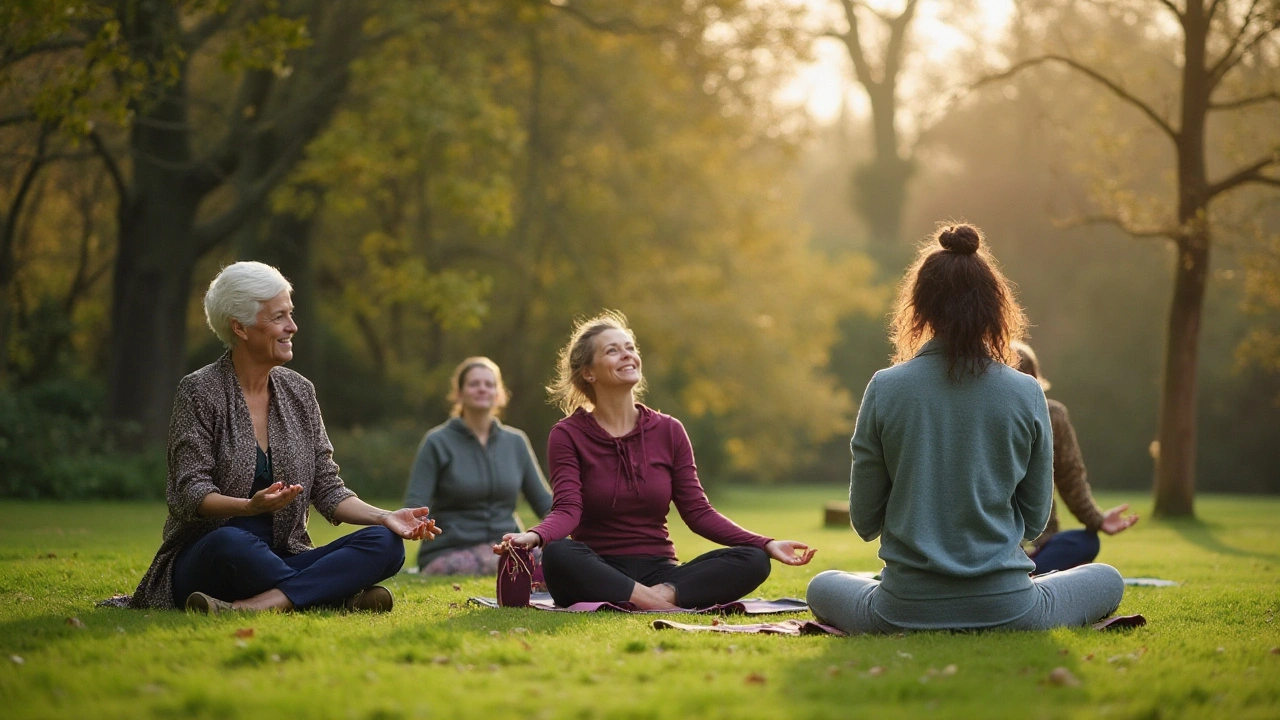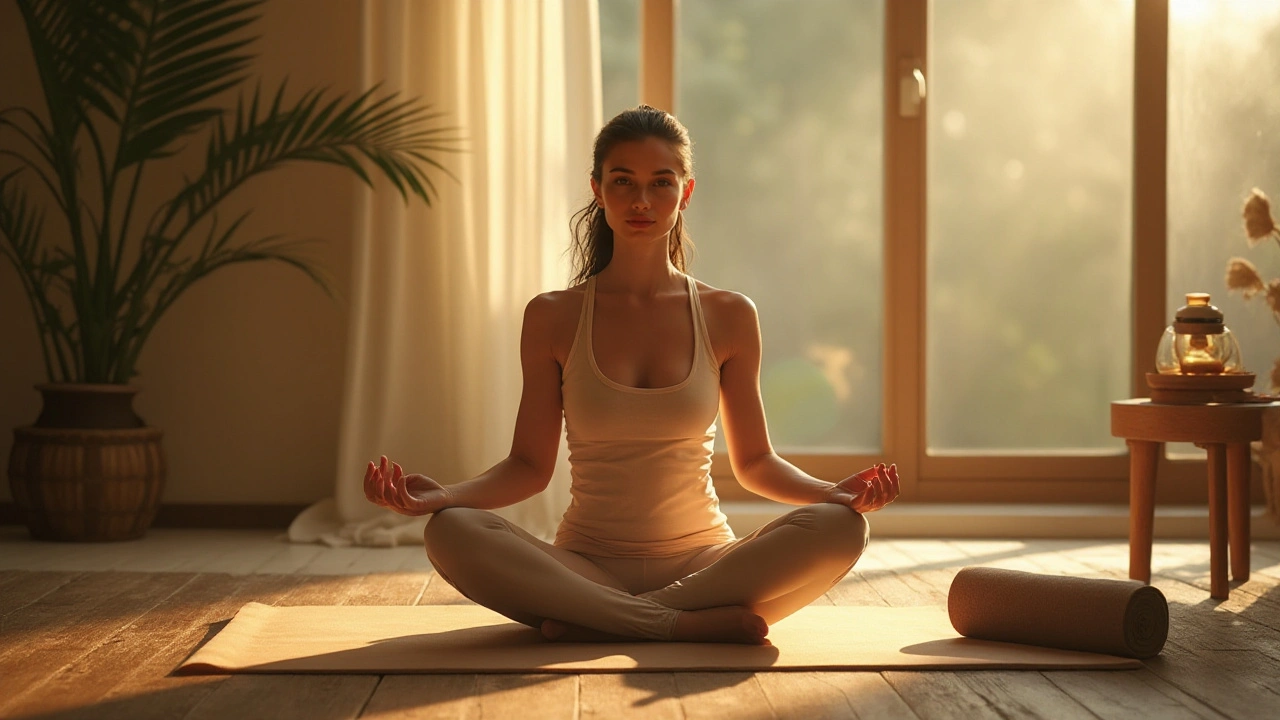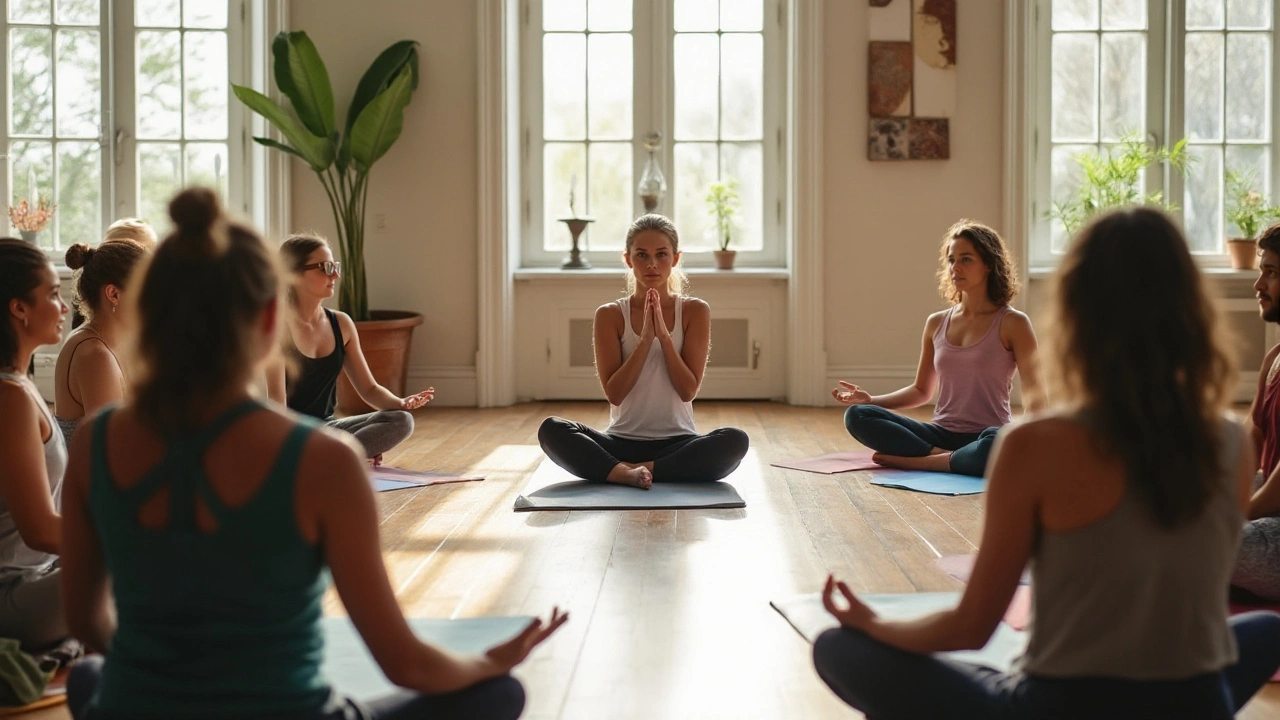Acu-Yoga might sound like just another trend in the vast world of fitness, but this ancient practice is anything but a passing fad. It's a seamless fusion of acupressure and yoga, two age-old disciplines that have stood the test of time due to their profound impacts on health and wellness.
For newcomers, understanding the basic premise and potential benefits of Acu-Yoga opens doors to a richer, more balanced way of life. It’s about touching the right points, stretching gently, and breathing mindfully, all while enjoying a sense of peace. This practice can not only elevate your physical health but also your mental clarity, offering a complete mind-body experience.
Whether you're looking to enhance your current fitness regime or seeking a new path to self-discovery, Acu-Yoga provides tools that are both accessible and transformative. Let's dive into the essentials of starting this practice and unlocking its benefits.
- Understanding Acu-Yoga
- Health Benefits of Acu-Yoga
- Essential Techniques for Beginners
- Incorporating Acu-Yoga into Daily Life
- Common Challenges and Tips
Understanding Acu-Yoga
Acu-Yoga is an intriguing blend of two profoundly impactful natural healing practices: yoga and acupressure. Born from the wisdom of age-old traditions, it allows practitioners to harness the harmonizing energies of both. This fusion targets the body's energy lines, or meridians, to relieve stress, enhance flexibility, and restore equilibrium. It effectively combines the gentle physical postures and stretches of yoga with strategic point pressure from acupressure. This dynamic duo invigorates the body's flow of energy or 'chi', leading to improved health and vitality.
For those unfamiliar, acupressure is like acupuncture’s less intimidating sibling. Instead of needles, it uses the firm touch of fingertips to stimulate the body's healing powers. Enhancing this with yoga, which already boasts benefits like increased flexibility and relaxation, creates a holistic wellness strategy. Yogic postures, or 'asanas', stretch and strengthen muscles, improving the efficiency of energy flow. Acu-Yoga takes this a step further by incorporating precise points of pressure that unlock tension and optimize the body's energy pathways. This practice allows not just physical improvement, but also helps in alleviating emotional and mental blockages.
"The art of healing comes from nature, not from the physician. Therefore, the physician must start from nature, with an open mind." — Paracelsus
Delving deeper into the fabric of Acu-Yoga, one discovers a world rich with cultural heritage and scientific curiosity. By stimulating specific acupressure points during yoga postures, it enhances the effects of both techniques. This interdisciplinary approach not only aids physical relief but also balances mental stress and emotional turmoil. Some of its reputed advantages include reduced anxiety, enhanced digestive function, better quality sleep, and pain relief. It’s an adaptable practice, which can be customized to align with varying health goals and personal preferences.
Anecdotal evidence from practitioners often cites significant improvements in stress management and mood stability, thanks to the unblocking of stagnant energy. Acu-Yoga encourages the practitioner to listen and respond to the subtle signals of the body. This practice of mindfulness, embedded in its core philosophy, leads to greater personal awareness and acceptance. By honoring both the energetic and anatomical aspects, Acu-Yoga creates a nurturing environment for both physical health and inner peace.
Interestingly, even scientific communities are now beginning to acknowledge the potential benefits of Acu-Yoga. Studies, though limited, show promising results of enhanced circulation and detoxification effects. One comprehensive study observed a group of adults practicing Acu-Yoga where it was found that 75% reported decreased levels of bodily tension and increased relaxation post-session. Such statistics provide a glimpse into how Acu-Yoga, with its intricate balance of strength and surrender, serves as a beacon of well-being.
Health Benefits of Acu-Yoga
Hidden within the elegant simplicity of Acu-Yoga are profound benefits that touch on various facets of well-being. By merging the principles of acupressure with yoga postures, practitioners can unlock a multitude of health advantages. At its core, Acu-Yoga is designed to relieve tension, improve circulation, and prompt the body's natural healing processes. The gentle stimulation of pressure points during yoga asanas acts like a massage for the body's energy highways, releasing blocked energy and facilitating smoother energy flow throughout. This results not only in reduced muscular tightness but also in an enhanced sense of relaxation and a decrease in stress levels.
Mental clarity and emotional balance are significant health benefits for those who regularly practice Acu-Yoga. As stress and anxiety are diminished through this holistic approach, many report a clearer mind and a more grounded emotional state. The mindful aspect of yoga combined with the focused energy of acupressure calms the nervous system, leading to better sleep and improved concentration. This kind of mental stillness and energy can translate into a more productive day, allowing individuals to feel more centered and present in their daily activities. In addition to this, the practice can support mental health by promoting a sense of well-being and happiness.
Flexibility and physical strength improve remarkably through regular sessions. The inclusion of acupressure helps muscles free up from any accumulated tension, thus enabling deeper and safer yoga postures. Often, practitioners find themselves achieving poses that seemed previously challenging. Alongside flexibility, there's an increase in physical endurance and balance. Regular practice tones the body, supporting joint health and improving posture, which can also alleviate common discomforts such as back pain. These are preventive measures, too, as they help maintain body resilience against injuries arising from daily activities.
One cannot overlook the digestive benefits that Acu-Yoga offers. By focusing on certain acupressure points related to the digestive system, practitioners can experience enhanced metabolism and relief from common digestive issues. The physical movements and stretches awaken a sluggish digestive system, promoting efficient nutrient absorption and toxin elimination. In a world where digestive disorders are increasing, this aspect provides a natural way to enhance gut health without significant dietary changes. As digestive health improves, so does overall energy, as the body becomes better at converting food into fuel.
A particularly appealing aspect of Acu-Yoga is its accessibility and adaptability. Regardless of one’s age or fitness level, the practice can be adjusted to fit personal needs and capabilities. Whether performed in a group setting or alone at home, the benefits remain impactful, making it an ideal wellness routine for a broad range of individuals. As Paramahansa Yogananda once said, "The deeper you go in the practice, the simpler life becomes, yet the more you find in it."
Yoga teacher and author B.K.S. Iyengar observed, "Yoga does not just change the way we see things, it transforms the person who sees."

Essential Techniques for Beginners
Starting a new practice like Acu-Yoga can be a transformative experience, and knowing the essential techniques is crucial for maximizing its benefits. At the core, Acu-Yoga combines elements of yoga poses, known as asanas, with acupressure, which involves applying pressure to specific points on the body. This unique synergy can aid in balancing the body's energy flow, improving flexibility, and enhancing mental focus. For beginners, it's important to cultivate a practice of patience and gentleness. Acu-Yoga encourages listening to your body and moving at your own pace, which helps build a deeper connection with yourself.
One of the foundational aspects involves learning simple asanas that align with energy pathways, often referred to as meridians. Basic poses like the downward dog, seated forward bend, and warrior pose are commonly used. These poses serve to open up energy channels, facilitate better circulation, and help in tension release. Coupled with focused breathing techniques, you can start noticing a calming effect both physically and emotionally. Breathing plays a pivotal role here; it's not just about inhaling and exhaling but doing so in a manner that harmonizes with your movements. Try to focus on breath awareness as you transition between poses.
Including specific acupressure points during your sessions is another beginner technique worth mastering. For example, the third eye point located between the eyebrows can be gently pressed during a seated meditation to alleviate stress and enhance concentration. Another crucial point is the union valley found between the thumb and index finger, often pressed to relieve tension headaches. While incorporating these points, aim to apply moderate pressure and hold for a few breaths. This promotes relaxation without causing discomfort. When practicing regularly, you'll likely notice significant improvements in stress reduction and clarity of mind.
According to renowned yoga instructor Rodney Yee, "When you combine the powerful principles of acupressure with the fluidity of yoga, you create a holistic discipline that nurtures the body and soul alike."
Beginners should also focus on establishing a consistent routine. Setting aside a quiet space in your home where you won't be interrupted can make a big difference. It's usually best to practice Acu-Yoga on an empty stomach, as it allows for greater ease of movement and minimizes any digestive distractions during your session. As with any new practice, consistency is key. Devote specific times of the day to your practice, such as morning or early evening, to align with your innate circadian rhythm. Gradually increase the duration of your sessions as you become more comfortable with the techniques.
An often-overlooked aspect of getting started is the importance of hydration. Keeping your body hydrated before and after sessions supports muscle function and replenishes lost fluids through perspiration. It’s a simple step, yet vital for sustaining energy levels. Additionally, tracking your progress with a journal can be quite rewarding. Note the days you practice, which techniques feel most beneficial, and any changes in your physical or mental state. This record can guide you in evolving your Acu-Yoga journey and adapting techniques according to your personal growth and needs.
Incorporating Acu-Yoga into Daily Life
Bringing Acu-Yoga into your daily routine can be a rewarding journey towards achieving better mental and physical health. It requires commitment and consistency, but the benefits speak for themselves. The fusion of yoga's mindful movement with acupressure's healing touch means that even short sessions can produce significant changes. Begin by dedicating a specific time each day for your practice. Early mornings or late evenings are ideal, providing a quiet space to focus on your body’s signals and needs.
Consider creating a designated area in your home for Acu-Yoga. This doesn’t have to be large—just a spot where you can lay down a mat and have a few inches of space around you. Keep this area organized and free of distractions. You might even enhance the ambiance with soft lighting, calming music, or scented candles. This space becomes your sanctuary, helping set the mental mood for your practice. What makes Acu-Yoga unique is its adaptability; you can practice it almost anywhere, whether at home, in a park, or while traveling.
Integrating specific Acu-Yoga sequences into your daily schedule can be as beneficial as kickstarting your day with a cup of coffee. For beginners, a routine might include deep breathing exercises to start, a few sun salutations to warm up, and then transitioning into specific acupressure points. Each session could be capped off with a brief meditation or mindful breathing. As you become more comfortable with the practice, feel free to tailor your sessions with a mix of stretches and pressure techniques that suit your needs.
If you find yourself strapped for time, even a few moments of Acu-Yoga can help. Begin with simple neck and shoulder acupressure while sitting at your desk or in the kitchen. You can press on specific points at intervals, maintaining your posture and breathing. Surprisingly, even these brief moments can relieve tension and restore balance to your mind and body. It’s not just about committing several hours a week, but about the small, rejuvenating pauses throughout the day.
Tips to Stay Consistent
- Set realistic goals: Start small and gradually build up your practice. Aiming for 10 minute sessions daily can be more sustainable.
- Track your progress: Keep a journal to document how you feel before and after each session, noting any improvements.
- Seek community: Joining local or online groups can provide motivation and share valuable insights.
- Learn continuously: Invest time in learning more about Acu-Yoga techniques through books or workshops.
- Be kind to yourself: Recognize that some days you'll feel more motivated than others, and that's perfectly okay.
"Combining yoga with acupressure provides a modern take on traditional practices, offering an accessible path to holistic health," says Sarah Longacre, a renowned wellness advocate.
As you incorporate Acu-Yoga into your lifestyle, the key lies in maintaining a balanced attitude. Honor your body by listening to its needs, challenging it one day, and nurturing it the next. With time and patience, this practice will seamlessly integrate into your life, bringing about positive outcomes in ways that exceed physical health, touching on mental clarity and emotional resilience as well.

Common Challenges and Tips
Diving into the world of Acu-Yoga can be a rewarding journey, yet like any new endeavor, it comes with its own set of challenges. One common hurdle beginners face is mastering the balance between acupressure and traditional yoga poses. It's crucial to understand that Acu-Yoga isn't about achieving perfect form instantly. Instead, focus on practice and patience, allowing your body to adapt over time.
A prevalent challenge is learning to locate and utilize the key pressure points during your practice. This could be a daunting task for those new to acupressure. Instead of becoming overwhelmed, focus on a few fundamental points initially. Research suggests beginning with easy-to-find points, such as the hands and feet, can significantly simplify the learning process. Engage in regular practice, and you'll find your comfort and expertise growing naturally.
Time management also poses a significant challenge for many aspiring practitioners. Fitting Acu-Yoga into a hectic schedule can seem burdensome. However, allocating just a few minutes each day can make a noticeable difference. Prioritize shorter, consistent sessions over sporadic lengthy ones. An effective tip is to incorporate Acu-Yoga into your morning or evening routine, ensuring it becomes a natural part of your lifestyle.
Weathering the Initial Awkwardness
Starting something new often feels awkward, and Acu-Yoga is no exception. Beginners often report experiencing awkwardness with poses or difficulty in self-administering precise pressure. Don't let the initial stumbling blocks deter you. Instead, focus on gradual improvement and embrace each practice session as a unique learning opportunity. Surrounding yourself with community support, whether through online forums or local classes, can provide encouragement and practical advice. Remember, every accomplished practitioner was once a beginner.
"Yoga is not about touching your toes, it is what you learn on the way down." - Jigar Gor
Another strategy is setting realistic goals for your Acu-Yoga journey. Initial expectations can sometimes be set too high, leading to unnecessary frustration. Break down goals into manageable steps, celebrating small victories along the way. Monitor your progress with a journal, noting both challenges and achievements.
Emphasizing posture and breathing helps mitigate frustration and enhance relaxation, which are crucial when you first start. Pay attention to your breathing patterns; they act as indicators of your comfort level in a pose. If discomfort occurs, ease off and try to maintain relaxed, even breaths.
Conquering Resistance with Routine
Experiencing resistance to regular practice is a common challenge. Motivation might dwindle over time, especially when progress appears slow. The key is to establish a routine that nurtures persistence. Linking your practice to a specific time or habit serves as a powerful reminder to persevere with your Acu-Yoga sessions. For example, practicing shortly after waking up or before bedtime can embed this routine seamlessly into daily life.
The journey to mastering Acu-Yoga is ongoing, and each challenge conquered opens up new layers of personal growth and understanding. Approach each session with an open mind and a willingness to learn, and your dedication will yield not only physical benefits but also mental clarity and peace.

